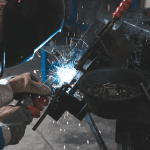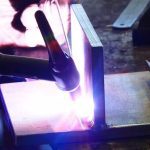TIG welding, also known as Tungsten Inert Gas welding, is a highly valuable method for joining metals, especially steel. This technique involves heating the metals using an arc created between the tungsten electrode and the base metal.
How to TIG Weld Steel
Welding Town
(Gas, Amps, Alloys, Polarity, Tips, etc)
Ultimate Guide
TIG Welding on Steel Gas Selection
Gas serves a diverse range of purposes in the welding process, each with its unique benefits. Primarily, it functions to shield the welding arc from contaminants like dust, air, and other gases. This protective gas environment also helps maintain clean and tidy welds on the base layer, ensuring a smooth welding process and effectively heating the metal. Additionally, blanketing gases can be employed to safeguard the metal after the welding process, providing further protection and preserving the integrity of the welded joint. Here are the lists of gases commonly used for each welding type that described below:
• Reactive and inert gases
• Purging gas
• Shielding gas
• Blanketing gas
• Heating gas
Gases play a crucial role in every welder’s job. Certain gases find extensive use in various applications, such as pure argon for numerous TIG welding steel projects, and a combination of CO2 and argon for several MIG welding jobs. When it comes to TIG welding on steel, the gas of choice for most welders is Argon.
Is Helium a Good Option?
Helium serves as an excellent choice for achieving successful TIG welding of carbon steel material. This non-reactive welding process results in clean and precise welds. Compared to argon, helium is hotter and more efficient in transmitting the arc’s heat, making it an advantageous option for specific welding applications.
Is co2 a Good Option?
You are correct. CO2 is not used for TIG welding due to its oxygen content, which can lead to oxidation and result in poor weld quality. Therefore, carbon dioxide should not be used in TIG welding.
Can I TIG Weld With 75% Argon & 25% co2 on Steel?
You are absolutely right. CO2 is an active gas and can cause oxidation when present around the tungsten electrode in a TIG welder. For TIG welding, it is essential to use pure argon to protect the electrode. Therefore, using an Argon-CO2 mix on steel during TIG welding is not recommended and considered a bad idea.












